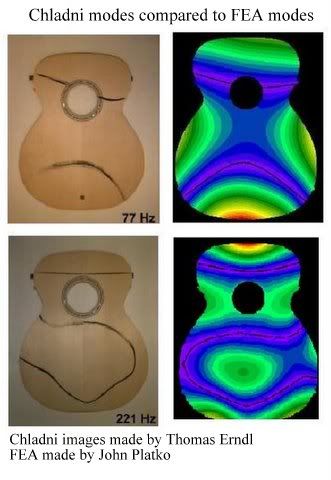Quote:
I watched the video. I'm not sure what I am looking at. Can you give some detail/clarity?
Sure. The thread was talking about tapping the back and hearing distinct "tones". When you tap the back you excite the natural frequencies. This works especially well if you hold the back at a node (a place where it doesn't move for certain resonant frequencies) and tap at an anti-node (a place where it moves a lot for certain resonant frequencies.)
If you tap with the fleshy part of a finger you tend to excite the lower modes. If you used something harder, like a knuckle, you get a bit more highs. You can just listen to the response of the plate to your tap, or you can use chladni pattern techniques (glitter and an audible sin wave) to show you where the nodes are for the lower frequencies. Once you see the nodes with chladni patterns you can imagine how the plate is actually vibrating. And knowing where the nodes are helps you figure out where to hold and where to tap. It might help you decided where to shave a brace.
The video I pointed out to you shows the simulated chladni pattern modes for a free back plate with fairly "normal" bracing. And the patterns are very similiar to what Al Carruth gets on his backs measured with his glitter technique. The video goes a step further and shows you how the plate moves for each mode, exaggerated so you can see it. You don't have to imagine. You might say, the video provides a visual picture of some of what you're hearing when you tap.
The video that I posted, like Chladni patterns, show the steady state response, so the damping is missing. When you tap, you hear the damping too. There are also ways to visulize the damping, both in a simulation environment like I'm showing or for an actual tap.
Here's an photo that compares the glitter pattern to my more detailed mode map for a top. It will show you what a node looks like on my mode plots. I drew a black line on the node on mode plot.

Of course you may end up with different mode patterns on your back but they should be in the ballpark of what I'm showing. The hope is, that this gives a better understanding of what's going on.
John